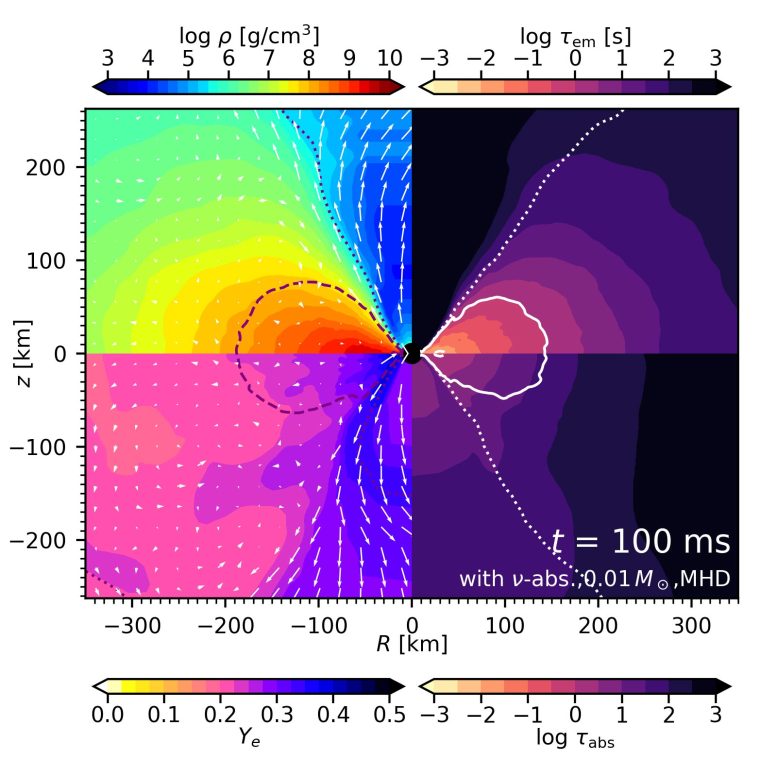Neutron-rich material is ejected from the disk, enabling the rapid neutron-capture process (r-process). The light blue region is a particularly fast ejection of matter, called a jet, which typically originates parallel to the disk’s rotation axis. Credit: National Radio Astronomy Observatory
How are chemical elements produced in our Universe? Where do heavy elements like gold and uranium come from? Using computer simulations, a research team from the GSI Helmholtzzentrum für Schwerionenforschung in Darmstadt, together with colleagues from Belgium and Japan, shows that the synthesis of heavy elements is typical for certain black holes with orbiting matter accumulations, so-called accretion disks. The predicted abundance of the formed elements provides insight into which heavy elements need to be studied in future laboratories — such as the Facility for Antiproton and Ion Research (FAIR), which is currently under construction — to unravel the origin of heavy elements. The results are published in the journal Monthly Notices of the Royal Astronomical Society.
All heavy elements on Earth today were formed under extreme conditions in astrophysical environments: inside stars, in stellar explosions, and during the collision of neutron stars. Researchers are intrigued with the question in which of these astrophysical events the appropriate conditions for the formation of the heaviest elements, such as gold or uranium, exist. The spectacular first observation of
Sectional view through the simulation of an accretion disk from the study by Dr. Just and his colleagues.
The black hole at the center is surrounded by torus-shaped matter several hundred kilometers in extent. The rotation axis of the disk is given by the z-axis, which runs at R=0 through the black hole along the vertical direction. The arrows illustrate the velocity distribution of the matter. The color shading shows the density (upper left), the proton fraction Ye (lower left), and the characteristic time scales of neutrino emission (upper right) and neutrino absorption (lower right). Values of Ye less than 0.5 indicate a high fraction of neutrons available for the r-process. Credit: GSI Helmholtz Centre for Heavy Ion Research
“In our study, we systematically investigated for the first time the conversion rates of neutrons and protons for a large number of disk configurations by means of elaborate computer simulations, and we found that the disks are very rich in neutrons as long as certain conditions are met,” explains Dr. Oliver Just from the Relativistic Astrophysics group of GSI’s research division Theory. “The decisive factor is the total mass of the disk. The more massive the disk, the more often neutrons are formed from protons through capture of electrons under emission of neutrinos, and are available for the synthesis of heavy elements by means of the r-process. However, if the mass of the disk is too high, the inverse reaction plays an increased role so that more neutrinos are recaptured by neutrons before they leave the disk. These neutrons are then converted back to protons, which hinders the r-process.” As the study shows, the optimal disk mass for prolific production of heavy elements is about 0.01 to 0.1 solar masses. The result provides strong evidence that neutron star mergers producing accretion disks with these exact masses could be the point of origin for a large fraction of the heavy elements. However, whether and how frequently such accretion disks occur in collapsar systems is currently unclear.
In addition to the possible processes of mass ejection, the research group led by Dr. Andreas Bauswein is also investigating the light signals generated by the ejected matter, which will be used to infer the mass and composition of the ejected matter in future observations of colliding neutron stars. An important building block for correctly reading these light signals is accurate knowledge of the masses and other properties of the newly formed elements. “These data are currently insufficient. But with the next generation of accelerators, such as FAIR, it will be possible to measure them with unprecedented (function(d, s, id){
var js, fjs = d.getElementsByTagName(s)[0];
if (d.getElementById(id)) return;
js = d.createElement(s); js.id = id;
js.src = "https://connect.facebook.net/en_US/sdk.js#xfbml=1&version=v2.6";
fjs.parentNode.insertBefore(js, fjs);
}(document, 'script', 'facebook-jssdk'));
Read original article here
